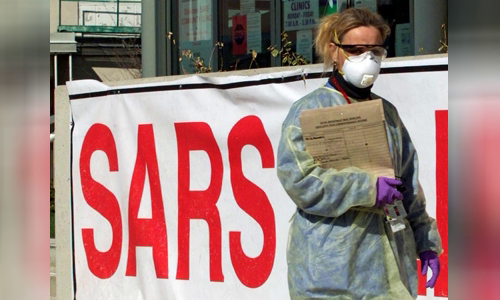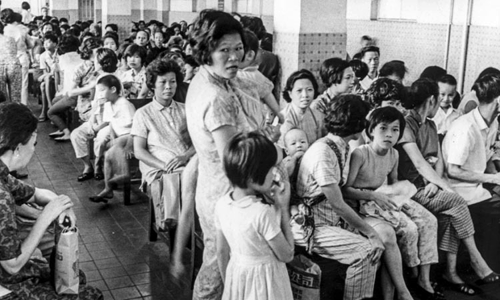The Chinese agriculture industry, where poultry and pigs are often kept close to each other, has long been considered a major cause of new strains of influenza virus.
Many of the historically serious pandemics originated in China, such as the Asian flu in 1957 or the Hong Kong flu in 1968. The livestock industry in developed countries often does not leave such consequences, because the production of The series in a given area focuses on a single type of meat.

A nurse outside a SARS clinic in a suburb of Toronto, Canada in April 2003 Photo: Reuters
In addition, meat after slaughter is often frozen, undergoing a series of intermediate hygiene measures before reaching customers. This helps to limit the possibility of cross-contamination between species, and at the same time facilitates product quality control and system monitoring.
Following the recent SARS outbreak nearly two decades ago and the recent outbreak of new coronavirus (nCoV) pneumonia, suspicion continued to spread to urban fresh markets in China, where people are increasingly exposed to the disease. more and more likely to like to try locally made wildlife foods.
Pandemic pneumonia outbreaks in Wuhan City, Hubei Province seem to repeat the SARS "nightmare", also known as Severe Acute Respiratory Syndrome, first appeared in November 2002 in the south. Guangdong province. The disease is also caused by a strain of corona virus, thought to have originated from bats, which is then transmitted to humans through civet civet sold at wildlife markets.
SARS is easily spread, with symptoms such as fever, chills, body aches and often pneumonia, with a mortality rate of 10%. It has sparked panic in Asia since early 2003, mainly in Singapore and China, especially Hong Kong Special Zone. The World Health Organization (WHO) on 12 March 2003 issued a health warning worldwide.
The SARS outbreak has been reported in 37 countries, with about 8,000 cases and 774 deaths. 80% of victims in China, Hong Kong alone recorded 300 deaths. The epidemic was controlled in 2003 and no cases have been reported since 2004.
Since the SARS outbreak, the Chinese government has rebuilt its infectious disease control system, strengthened its information sharing network both at home and abroad, and established an online real-time reporting system. Nationwide, used in public health emergencies and infectious diseases appear. Ironically, it is this strict control system that is blamed for the delay in confirming new nCoV infections.
Before SARS, China had trouble with H5N1 bird flu in 1997 causing 18 people infected with the virus, including 6 died in Hong Kong, shortly after the special zone was returned to the mainland by the UK. Mainland China is suspected of being the source of the disease by 80% of poultry imported from Hong Kong.
Hong Kong authorities ordered the destruction of 1.5 million poultry, including chickens, ducks and pigeons, to prevent the virus from spreading. This strain is particularly dangerous to domestic poultry and most human cases are in direct contact with infected animals. Symptoms include conditions like pneumonia and multiple organ failure, with a death rate of nearly 60%, according to WHO.
Avian influenza is not considered a human disease, as human-to-human transmission of H5N1 virus is extremely limited, despite concerns that it will develop into a contagious form. Despite this, the virus became a serious threat when it reappeared in 2003 in Southeast Asia, spreading to 15 countries, killing 282 people in 468 cases, according to WHO data.
Also originating from an influenza A virus strain, such as H5N1, called H3N2, the Hong Kong flu pandemic began spreading in the city in July 1968, making 500,000 people sick, accounting for 15% of the population here. . The disease then spread throughout Asia and spread to the United States, Europe, Australia and Africa in just a few weeks.

The patient filled the waiting area of a clinic in Hong Kong in July 1968 Photo: SCMP
Considered to be the first pandemic of modern times, one of the driving forces for the rapid spread of Hong Kong flu is the development of the international aviation industry. WHO must mobilize and coordinate large-scale global support efforts to address this pandemic.
The Hong Kong pandemic is estimated to have killed one million people, according to the US Centers for Disease Control and Prevention (CDC). Although the mortality rate is lower than the Spanish flu (1919-1920), the pandemic made 500 million people worldwide infected and 50-100 million died, the Hong Kong flu spread very quickly. Symptoms last 4 to 5 days, in some cases up to two weeks.
In November 1968, scientists successfully developed a vaccine to help prevent disease effectively. In a 1969 report, WHO assessed Hong Kong's cooperation to make the research process "as fast as possible".
In January 1970, the New York Times reported that "scientists suspect at least three recent flu pandemics have originated in mainland China". The article quoted Dr. Chang Wai-kwan at Queen Mary Hospital in Hong Kong during an international conference, that the 1957 Hong Kong and Asian flu "seemed to have originated in mainland China."
The first cases of Asian flu, also caused by a type A virus called H2N2, were identified in February 1957 in Guizhou Province, southwestern China. The virus spread throughout the country and around the world, becoming the most serious pandemic since the Spanish flu.
Research shows that H2N2 is a mixed strain, derived from avian and human influenza strains. Like the Hong Kong flu, some people with Asian flu experience only symptoms such as cough and mild fever, but many other serious complications become pneumonia and death.
Two outbreaks have occurred during this pandemic. In the first months, the virus spread throughout China and surrounding areas. By mid-summer of 1957, the disease spread to the United States, but at first it seemed there were relatively few people infected. A few months later, the number of cases suddenly increased, especially among children, the elderly and pregnant women, creating the second outbreak of the disease in the Northern Hemisphere in November 1957. The CDC estimates 1.1 million people worldwide die during the Asian pandemic.
Also according to the January 1970 article of the New York Times, Spain was not the place where the Spanish flu outbreak was thought to be the most dangerous in 1918 history, but China. A 2018 article in the British Medical Journal also agreed with this view.
The virus that causes the pandemic is thought to originate from birds, pigs or both. Claude Hannoun, a leading expert on the 1918 influenza pandemic at the Pasteur Institute, said the virus is likely to start in China. Later, it transformed in the United States and from there spread to France and throughout Europe, causing a total of 500 million people to be infected and 50-100 million, or 3-5% of the world's population at the time, death. casualties.



 LisaLawsPeaks
LisaLawsPeaks







